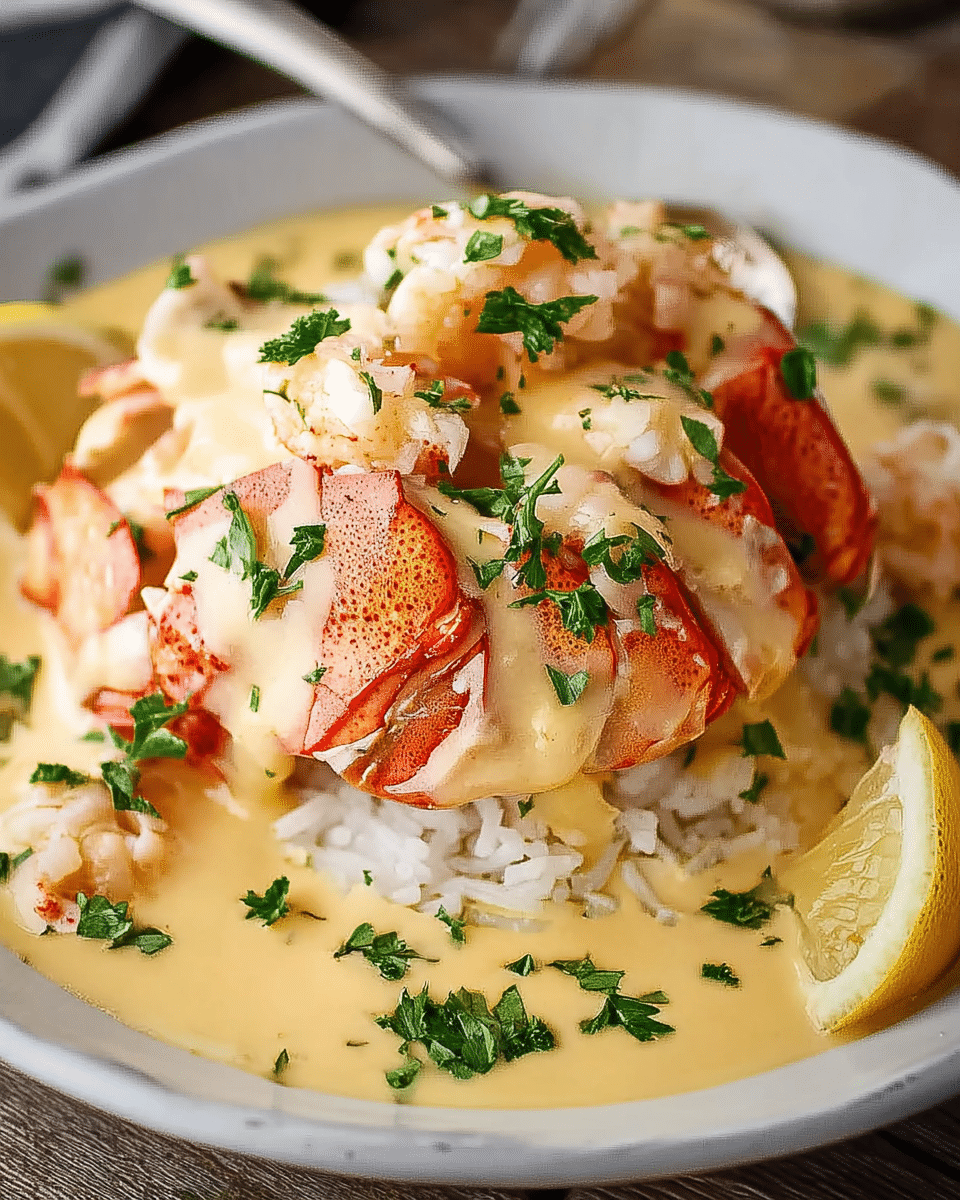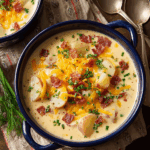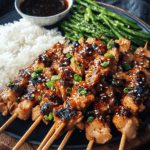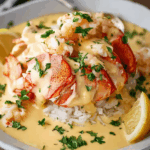The luxurious appeal of Lobster Newburg lies in its rich history and indulgent flavors. This timeless dish showcases sweet lobster meat nestled in a silky, brandy-kissed cream sauce that’s thickened just right with a delicate roux. Every bite melts in your mouth, delivering a warm, savory experience ideal for celebrations or a romantic evening in.
Not only is it a feast for the palate, but it’s also visually stunning perfect for impressing dinner guests or treating yourself. Serve it over toasted brioche, rice, or delicate pasta to soak up every drop of that velvety sauce. Whether you’re honoring a holiday or just in the mood for something luxurious, this Lobster Newburg promises culinary excellence.
Full Recipe:
Ingredients:
-
1 ½ pounds lobster meat (cooked, fresh or frozen)
-
4 tablespoons unsalted butter
-
½ cup finely chopped onion
-
1 cup sliced mushrooms
-
¼ cup all-purpose flour
-
2 cups lobster stock (or chicken stock)
-
1 cup heavy cream
-
2 egg yolks
-
2 tablespoons brandy (optional)
-
1 teaspoon Worcestershire sauce
-
½ teaspoon paprika
-
Salt and pepper to taste
-
Fresh parsley, chopped (for garnish)
Directions:
-
If using whole lobsters, boil in salted water for 8–10 minutes. Remove meat and cut into bite-sized pieces.
-
Melt butter in a large skillet over medium heat. Add onion and mushrooms, sauté until translucent.
-
Sprinkle flour over mixture, stirring continuously to form a roux (2–3 minutes).
-
Slowly whisk in the stock, ensuring smoothness. Stir until thickened.
-
Reduce heat, add heavy cream, and stir until incorporated.
-
In a separate bowl, temper egg yolks by mixing with a few tablespoons of hot sauce. Stir back into the skillet gently.
-
Add brandy (if using), Worcestershire, paprika, salt, and pepper. Simmer 5 minutes.
-
Gently fold in lobster meat and cook for a few minutes until heated through.
-
Taste and adjust seasoning.
-
Serve hot, garnished with parsley.
Prep Time: 15 minutes | Cooking Time: 30 minutes | Total Time: 45 minutes
Kcal: 480 kcal | Servings: 4–6 servings
Classic Lobster Newburg: A Gourmet Journey Through History and Flavor
Few dishes in the realm of seafood can boast the opulence, historical charm, and culinary prestige of Lobster Newburg. Rich, velvety, and layered with nuanced flavors, this classic recipe transcends mere sustenance. It’s a symbol of luxury, a staple of fine dining menus, and a favorite among seafood aficionados who appreciate the artistry of a perfectly crafted cream sauce enveloping sweet, tender lobster meat.
A Taste of History
Lobster Newburg’s story begins not in a quaint fishing village or a coastal family kitchen, but in the lavish dining rooms of 19th-century New York City. The dish is widely attributed to Delmonico’s Restaurant, one of America’s earliest fine-dining establishments. According to culinary lore, the recipe was introduced by a wealthy sea captain named Ben Wenberg. After demonstrating the preparation to the restaurant’s chef, Charles Ranhofer, the dish was added to the menu under the name “Lobster à la Wenberg.”
However, a falling out between Wenberg and the restaurant led to his name being reversed, and thus the dish was rebranded as “Lobster Newburg.” Despite the name change, it retained its luxurious appeal and quickly became one of Delmonico’s most popular offerings, eventually making its way into the broader fabric of American cuisine.
What Makes It Unique?
Unlike many modern lobster dishes that focus on simplicity or raw presentation, Lobster Newburg is a celebration of culinary technique and indulgence. The essence of the dish lies in its decadent sauce, traditionally made from butter, cream, egg yolks, and a splash of brandy or sherry. These ingredients are gently blended to create a smooth, custard-like consistency that perfectly complements the natural sweetness of lobster.
The use of brandy or sherry is particularly significant. It adds a warming, aromatic depth to the sauce, cutting through the richness with subtle complexity. While variations exist, the core of the dish remains consistent: rich lobster meat coated in a creamy, fortified sauce that evokes both comfort and sophistication.
Perfect for Special Occasions
Lobster Newburg is not your average weeknight dinner. It’s a dish best reserved for moments when celebration is in the air whether it’s a romantic anniversary, a festive holiday, or a luxurious dinner party. It speaks of effort, of refinement, and of a desire to create something memorable.
What makes it especially versatile is how it can be served. While some prefer it elegantly spooned over toasted brioche or puff pastry, others pair it with buttered noodles, wild rice, or mashed potatoes. Its creamy richness also makes it a wonderful filling for vol au vent pastry shells, turning it into a perfect hors d’oeuvre or appetizer for upscale events.
A Dish That Demands Technique
Though the ingredients may appear simple at first glance, the process of making Lobster Newburg calls for culinary finesse. It’s easy to underestimate the skill required to temper egg yolks into a hot sauce without curdling them or to deglaze a pan just enough to extract the best flavors from seafood and brandy without overpowering the balance. The cook must also be cautious not to overcook the lobster, which is delicate and prone to toughness when exposed to prolonged heat.
For chefs and home cooks alike, Lobster Newburg presents both a challenge and a reward. It demands patience, attention, and care but offers a dish that truly shines when done right.
Variations and Modern Twists
As with any classic recipe, interpretation and innovation have given rise to a host of modern variations on Lobster Newburg. Some chefs swap the lobster for shrimp or scallops for a different seafood profile, while others experiment with crab meat or even plant-based lobster substitutes to make it more accessible to various diets.
Gluten-free versions often skip the flour-based roux and rely instead on reduction techniques or cornstarch slurries to thicken the sauce. In some cases, chefs add fresh herbs like tarragon or chives for an aromatic finish, or even a touch of cayenne or smoked paprika for added warmth and color.
Vegetable lovers sometimes incorporate asparagus or peas into the mix for texture and visual contrast. Others experiment with exotic mushrooms or add a bit of saffron for a deeper, more luxurious flavor and a golden hue.
Wine Pairing Recommendations
A dish as rich and layered as Lobster Newburg deserves a carefully chosen wine pairing. Since the sauce is cream-based and often enhanced with brandy, a white wine with good acidity is essential to balance the richness.
A classic Chardonnay, especially one with moderate oak influence, works beautifully with the buttery texture and subtle nutty notes of the dish. For those who prefer a crisper profile, Sauvignon Blanc or Vermentino can offer refreshing contrast with their citrus and herbal tones.
Sparkling wines such as Champagne or Crémant also pair exceptionally well, especially when the dish is served as a starter or canapé. Their effervescence cuts through the cream and prepares the palate for the next bite.
Presentation and Plating Tips
The elegance of Lobster Newburg is only matched by its visual appeal when plated thoughtfully. It’s important to let the lobster be the star vibrant, succulent, and glistening with sauce.
Try serving it in shallow white bowls or porcelain ramekins, garnished with freshly chopped parsley or a delicate microgreen for a splash of color. A drizzle of the brandy cream sauce over the top adds a professional touch.
If you’re using puff pastry, ensure it’s golden and crisp to add both texture and visual contrast. For multi-course dinners, consider serving smaller portions in tasting spoons or shot glasses for a chic, contemporary presentation.
Cultural Legacy and Popularity
Lobster Newburg has managed to maintain its place in the culinary spotlight for over a century no small feat in a world where food trends come and go with dizzying speed. Its inclusion in vintage cookbooks, holiday menus, and white-tablecloth restaurants speaks to its enduring charm.
The dish is also a reminder of a time when American cuisine began to embrace European techniques while still celebrating local ingredients like Maine lobster. In many ways, Lobster Newburg represents the birth of American haute cuisine, a blend of tradition, innovation, and indulgence.
Even today, when chefs seek to revisit the classics or pay homage to historical dishes, Lobster Newburg often finds its way back into the conversation a testament to its staying power and timeless appeal.
Conclusion:
Classic Lobster Newburg is far more than the sum of its parts. It’s a dish steeped in history, refined through technique, and celebrated for its flavor and richness. Whether you serve it at a holiday gathering, an anniversary dinner, or a high end seafood tasting menu, it delivers a culinary experience that is as luxurious as it is satisfying.
From its roots in 19th-century New York to its place in the modern gourmet kitchen, Lobster Newburg has stood the test of time. Its elegance lies not just in the quality of the ingredients, but in the care with which it’s prepared and presented. For those who value classic cuisine and are unafraid to indulge in the finer things, this dish is an essential addition to your culinary repertoire.






